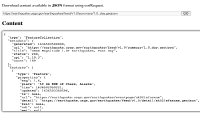 Hide Table of Contents
Hide Table of Contents
 Analysis
Analysis
 Dynamic Layers
Dynamic Layers
 Editing
Editing
 Feature Layers
Feature Layers
 Feature Table
Feature Table
 Graphics
Graphics
 Map
Map
 Mobile
Mobile
 Online and Portal
Online and Portal
 Popups and Info Windows
Popups and Info Windows
 Query and Select
Query and Select
 Renderers, Symbols, Visualization
Renderers, Symbols, Visualization
 Search
Search

Explore in the sandbox
Open in CodePen
View live sample
Description
This sample shows how to use esriRequest to download content in JSON format. The snippet below uses this method to retrieve earthquake data in GeoJSON format fromUSGS Earthquakes Hazards Program.
Once the content is loaded we can access and display this information. The dojo.toJson method is used to convert the JavaScript object and its properties and values into simple text. The response is a JavaScript object, you can access its properties using code like this:
console.log("Title: ", response.value.title);
console.log("Description for first item: ", response.value.items[0].description);
"XMLHttpRequest" objects are subject to the browsersame origin security policy. This means that when downloading content with this method you need to setup a proxy if the content is from another origin.
Code
<!DOCTYPE html>
<html>
<head>
<title>JSON Content</title>
<meta http-equiv="Content-Type" content="text/html; charset=utf-8">
<link rel="stylesheet" href="https://js.arcgis.com/3.46/esri/css/esri.css">
<style>
body{
font-family: "Arial Unicode MS, Arial, sans-serif";
}
#content {
width: 800px; height: 350px; padding: 5px; overflow: auto;
border: solid 2px #AAAAAA; background-color: #FFFFFF;
border-radius: 5px;
-moz-box-shadow: 0 0 0.5em black; -webkit-box-shadow: 0 0 0.5em black; -o-box-shadow: 0 0 0.5em black; box-shadow: 0 0 0.5em black;
}
.failure { color: red; }
#status { font-size: 12px; }
</style>
<script src="https://js.arcgis.com/3.46/"></script>
<script>
require([
"dojo/dom",
"dojo/on",
"dojo/dom-class",
"dojo/_base/json",
"esri/config",
"esri/request",
"dojo/domReady!"
],
function(
dom,
on,
domClass,
dojoJson,
esriConfig,
esriRequest
) {
// Use CORS
esriConfig.defaults.io.corsEnabledServers.push("earthquake.usgs.gov"); // supports CORS
dom.byId("url").value = "https://earthquake.usgs.gov/earthquakes/feed/v1.0/summary/1.0_day.geojson";
dom.byId("content").value = "";
//handle the Go button's click event
on(dom.byId("submitRequest"), "click", getContent);
function getContent(){
var contentDiv = dom.byId("content");
contentDiv.value = "";
domClass.remove(contentDiv, "failure");
dom.byId("status").innerHTML = "Downloading...";
var requestHandle = esriRequest({
"url": dom.byId("url").value
});
requestHandle.then(requestSucceeded, requestFailed);
}
function requestSucceeded(response, io){
dom.byId("status").innerHTML = "";
dojoJson.toJsonIndentStr = " ";
dom.byId("content").value = dojoJson.toJson(response, true);
}
function requestFailed(error, io){
domClass.add(dom.byId("content"), "failure");
dom.byId("status").innerHTML = "";
dojoJson.toJsonIndentStr = " ";
dom.byId("content").value = dojoJson.toJson(error, true);
}
});
</script>
</head>
<body>
<p>Download content available in <b>JSON</b> format using esriRequest. </p>
<p>
<input type="text" disabled="true" id="url" size="100"/>
<input id="submitRequest" type="button" value="GO" />
<span id="status"></span>
</p>
<h2>Content</h2>
<textarea id="content"></textarea>
</body>
</html>